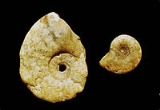
Schloenbachia
Encyclopedia
Schloenbachia is an ammonoid cephalopod genus from the Cenomanian
Cenomanian
The Cenomanian is, in the ICS' geological timescale the oldest or earliest age of the Late Cretaceous epoch or the lowest stage of the Upper Cretaceous series. An age is a unit of geochronology: it is a unit of time; the stage is a unit in the stratigraphic column deposited during the corresponding...
stage of the Upper Cretaceous
Cretaceous
The Cretaceous , derived from the Latin "creta" , usually abbreviated K for its German translation Kreide , is a geologic period and system from circa to million years ago. In the geologic timescale, the Cretaceous follows the Jurassic period and is followed by the Paleogene period of the...
, and type for the Schloenbachiidae
Schloenbachiidae
Shloenbachiidae is a family of hoplitacean ammonoid cephalopds mostly from the lower Upper Cretaceous, .Shloenbachiidae can be recognized by their usually keel bearing, irregularly ribbed and tuberculate shells that vary from evolute to rather involute and compressed to inflated...
, a family within the ammonitid Hoplitaceae
Hoplitaceae
Hoplitaceae is a superfamily of mostly Upper Cretaceous ammonites comprising families united by a similar suture pattern with multiple similar elements that tend to decrease in size going toward the umbilicus, at the inner edge of any whorl, and which are typically in a straight line...
.
Schloenbachia was named by Newmayer, 1875, the type species is Schloenbachia varians (Sowerby 1817). The genus has been found in Europe (France, Germany, England), the Middle East (Iran), and North America (California, Orgeon).
Schloenbachia varians
Schloenbachia varians, known from Europe and Iran, is a highly varied species with a number of possible synonyms. Variations include S. varians (var) subvarinas, S.v. (var) subtuberculata, S.v. (var) ventricosa,and S.v. (var) varians..Schloenbachia varians comprises a highly variable group of medium-sized, involute and compressed to evolute and highly inflated, weak to strongly keeled ammonites, most all of which bear umbilical and lower lateral tubercles. Compressed forms may be smooth and constricted. More inflated forms usually have flexious ribs that arise from lower lateral tubercles ending in strong clavi at the ventrolateral ends. The variations included cannot be regarded as geographic subspecies or successive chrono-subspecies, but reflect a high degree of variability in shell form and ornament (phenotypic plasticity) in S. varians.
Schloenbachia in western North America
A suite of species attributed to Schloenbachia have been described from Upper Cretaceous sediments in Calfornia and Oregon (Chico Formation and equivalents), including among others Schloenbachia chicoensis, S. knighteni, S. multicostata, S. oregonensis, and S. siskiyouensis. These differ in the nature of the ribbing, tuberculation, and keel as well as the degree of compression or inflation of the shell.Most come from northern California and Oregon, however two species Schloenbachia knighteni and Schloenbachia siskiyouensis have been found in the coastal mountains in southern Calfiornia east of Santa Anna .

